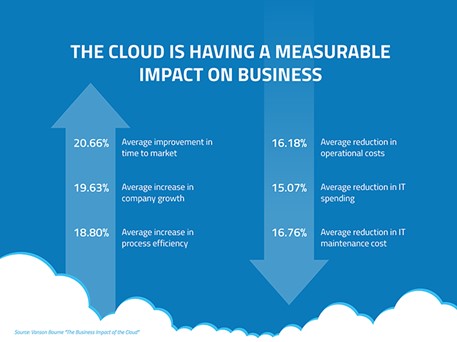
When Does a Technology Become a Solution?
April 01, 2025 at 5:00 PM EST
According to Gartner’s 2024 Cloud Strategy Cookbook, up to 30% of enterprises are considering moving some or all their cloud applications back into their facilities, a practice known as cloud repatriation. The primary driver is cost overruns, which is ironic considering that cost savings is one of the most attractive aspects of cloud adoption.
Gartner isn’t the only company to spot this trend. In a 2024 Barclay’s CIO survey, 83% of enterprise CIOs said they plan to repatriate at least some cloud workloads in 2024, compared to 43% in late 2020. Similar research from multiple organizations confirms that a growing number of companies are considering cloud repatriation.
What’s driving the cloud exodus? Research indicates that it’s less about the cloud model or its limitations and more about companies’ strategic missteps in their cloud adoption journeys. Cloud repatriation is just one example of a much larger issue that has plagued businesses since, well, forever: failing to understand the difference between a technology and a solution. In this blog, we’ll take a closer look at this and explain when, exactly, a technology becomes a solution.
The difference between technology and a solution
Simply put, technology is merely a tool designed to be used to help solve an issue or capitalize on an opportunity. It’s a means to an end, not the end itself. As technologies evolve, however, they often overshadow the applications for which they were developed. Cloud repatriation is a perfect example.
Around ten years ago, cloud computing was coming into its own. The business opportunities, cost savings and operational flexibility that it offered seemed limitless. The illustration below is an example of the hype surrounding the cloud in 2015. And businesses bought in. Ten years later, nearly a third of those businesses are rethinking their decision, either partially or entirely. As noted earlier, the issue isn’t that cloud computing didn’t live up to its hype; the benefits of the technology have been clearly and repeatedly quantified and demonstrated. The problem is implementation and that’s the key difference between technology and a solution.

How to avoid the technology trap
The goal of any business initiative should be to deliver value, however you define it. The specific technology, strategy or tactic you choose is just one ingredient in the recipe for success. The allure of a new and promising technology often obscures and skews this perspective. To avoid this trap, business owners must remain laser-focused on the problem or opportunity driving the initiative.
In an October 2024 blog, Russell Shilling, a former Program Manager with DARPA suggests: “Never start a project by asking, ‘How can AI improve X.’ Instead, ask, ‘We haven’t been able to effectively solve this problem; could AI be the piece we are missing?’ This shift in mindset is critical.”
While Shilling’s advice seems simple enough, it can be surprisingly hard to follow. Evidence for the role of emotions in the B2B buying decision is strong. Research indicates that as much as 84 percent of B2B buyers base their decisions on emotion as opposed to rigorous cost/benefit analysis.
It is critical that business owners remain focused on what they are trying to do instead of how to use a specific technology that may or may not work. This problem-centric approach accomplishes two important things. First, it helps keep a specific technology in perspective as one of many means to an end.
Second, it helps broaden the focus to include all aspects of implementation that must be considered to ensure the project delivers the expected value. These other critical aspects include pre-project planning, deployment strategy, Day 2 scaling and management, adoption of upgrades, evaluation metrics and more. While such tasks are the foundational blocking and tackling that determine the success of any business initiative, it is striking how often they are overshadowed by the excitement of a new technology.
Having an experienced and objective advisor who can help keep the business’s efforts focused can be the difference between success and struggle.
Stay focused on the big picture with Glo Fiber Business
Oftentimes, the management team is so close to the company and its mindset that it is difficult to step back from day-to-day operational issues and focus on the multi-dimensional aspects of properly and fully implementing a new technology. The challenge isn’t only one of perspective, it also requires a range of expertise and resources that many organizations don’t have in-house. This is where having a dedicated network partner like Glo Fiber Business can help.
Glo Fiber Business is a leading provider of fiber-to-the-business, Ethernet networking, cloud-hosted voice, data center connectivity and managed network services across Virginia, West Virginia, Pennsylvania, Maryland, Kentucky, Delaware, Ohio, and Indiana. With 130 years of information and communications technology experience, we help customers transform network technologies into powerful customized solutions capable of driving productivity, operational efficiency and scalable growth.
Every day we work with small businesses and larger enterprises, government agencies, healthcare and educational systems, wholesale network providers, manufacturers and more. We ask the questions and provide the implementation guidance that keep them focused on the big picture. Business customers rely on Glo Fiber Business for end-to-end project implementation, including Day 0 assessment and design, Day 1 deployment and customization and Day 2 management and ROI optimization. To transform the next big idea into a meaningful and valuable business strategy, these elements must come together. That’s exactly what Glo Fiber Business provides.
When does a technology become a solution? When it is thoughtfully planned, adequately provisioned and successfully implemented. To learn how Glo Fiber Business can help you stay focused on the big picture while ensuring no detail is overlooked, schedule a meeting to talk to one of our experienced Account Executives today.